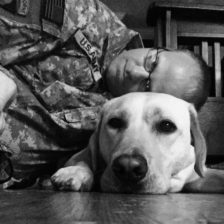Not all wounds from war are visible. I’m sure you’ve heard that from someone, or you may know that. But, did you know that June is PTSD Awareness Month?
Connecting with others is a big part of my life. I work with college students and I help them learn how to write at the college level, I teach them about communication and connection with others. I consider myself a lifelong learner, and I think understanding more about PTSD can be helpful (especially if you aren’t aware of the signs and symptoms or triggers of PTSD).
Educating/reading/learning can be key—and that is just how I started understanding PTSD myself.
Traumatic stress and trauma exposure is common. There can be daily hassles, major life events, and serious traumatic events. Veterans and those who are currently serving in our military are not the only people who can be exposed to PTSD, unfortunately, some people think that all Veterans have some form (notice: I said some people…not all people…and not all Veterans have PTSD, just saying).
Traumatic stress of daily hassles can be a car breaking down or paying bills. Major life events can be losing a job, getting a divorce, buying a new home, or even getting married. There are some serious traumatic events that can include war zone exposure, physical or sexual assault, serious accidents, child sexual or physical abuse, natural disasters, and torture.
Over 60% of men and over half of all women experience at least one traumatic event (according to the VA). That means that most of the people you meet every day have probably experienced a trauma in their lifetime (including someone who may be a Veteran).
Only about 7% of all people develop PTSD in their lifetime. A traumatic event can be directly experiencing a traumatic event, witnessing, in person, an event that happened to someone else, learning about the violent or unexpected death of a loved one or family member, and experiencing repeated or extreme exposure to aversive details of traumatic events.
In addition to the type of trauma experienced, a diagnosis of PTSD requires a combination of symptoms from specific symptom clusters: intrusion (or re-experiencing), avoidance, negative alterations in cognition and mood, and alterations in arousal and reactivity (or hyperarousal). These symptoms must be present for more than one month and must cause significant distress—doesn’t that sound very medical and formal?
I’ve witnessed Sam have some of those specific symptoms…avoidance, mood swings, hyperarousal, difficulty with memory, nightmares/difficulty sleeping, flashbacks, trying to avoid memories or feelings, negative emotions…at times I thought Sam might be constantly on guard or constantly scanning for danger…he startled easily. He wanted to sit at the back of the theatre, sit near an exit, sit where he could see people, but he tried to cope with that every.single.day. I watched Sam get super frustrated with traffic, with people and even waiting in a line at the store. Too many people seemed to be a problem, and he got anxious and annoyed.
Sleeping through the night was a problem for Sam. At night, when the rest of the house was quiet, his mind was racing, thoughts were swirling around in his head. Flashbacks and nightmares sometimes occur. Pre-Memphis, that was a problem. It was hard to sleep. It was hard to function the next day. Isolation would have been ideal, but Sam pushed forward, he wore a mask and he wore it well.
We hear about PTSD quite a bit, most of the time in a negative light, but I think with a little education and more understanding the civilian population will understand the signs, symptoms, and struggles that some folks have with PTSD. Educate yourself.
Encourage someone to reach out if they are struggling with PTSD. Support those who may be going through some rough times. Invisible wounds cannot be seen with the eye, but knowing and understanding that there are signs and symptoms of PTSD might help someone, it might even save a life.




During war, after war, and with Memphis. These are some of the stages of PTSD for Sam. Missions and deployments were a lot different than spending the night at home on a Friday night, going out for a hike, and taking a trip across the country. While he still battles, there are some who do not want to fight or do not have the support they need. PTSD is real. We need to do more to be aware and we need to help those who struggle.
